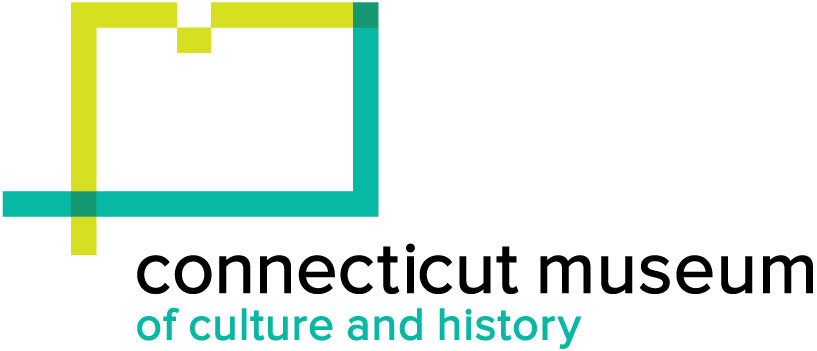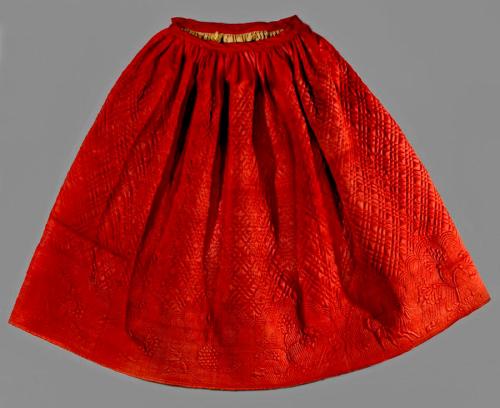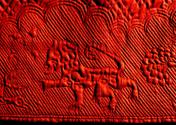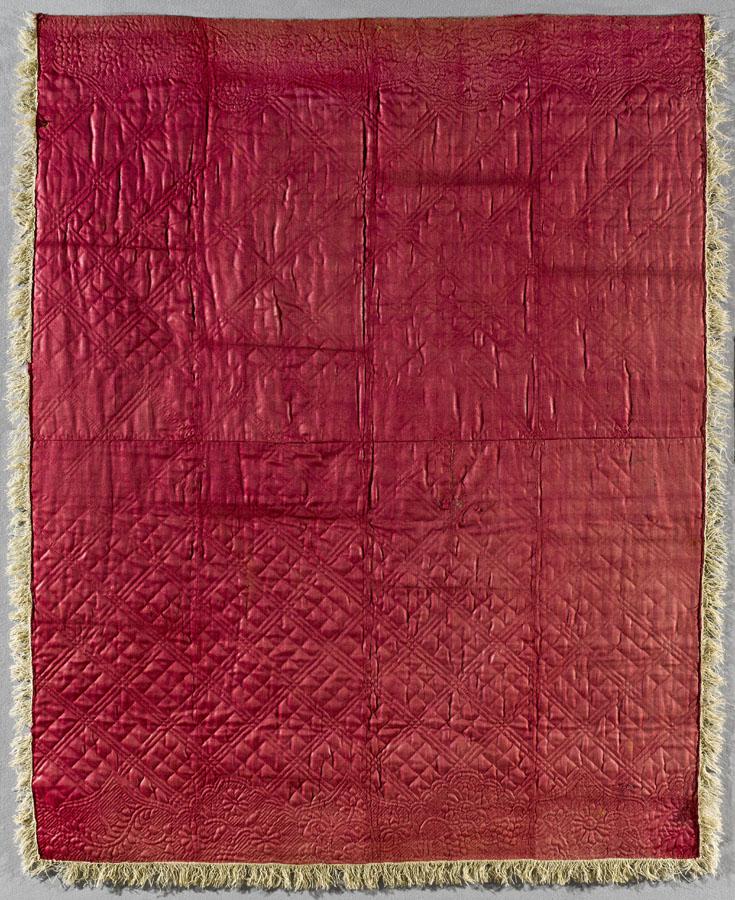Quilted Petticoat
Original OwnerOriginally owned by
Sarah Halsey
(American, 1741 - 1828)
Clothing MakerMade by
Unknown
Date1758
MediumHand-quilted with silk thread; satin-woven worsted face, wool batting, wool lining
DimensionsPrimary Dimensions (length): 39 1/2in. (100.3cm)
Hem (circumference): 116in. (294.6cm)
ClassificationsCostume
Credit LineGift of the Lyman Allyn Museum, New London
Object number1959.54.2
DescriptionRed satin-woven worsted petticoat, quilted in cream-colored and golden brown silk threads with various designs extending ten inches above the hem; above this, the quilted pattern is a trellis-like design, stitched in groups of three lines. Above the scallops, the body of the petticoat is quilted in a diamond pattern, with triple rows of stitching creating the diamonds. The quilting ends four inches below the waistband, and there is no wadding in this area.
The decorative band around the hem includes figures of a mermaid, lion, a griffin or leopard, a fish, 2 stags, 3 rabbits, 3 different birds, and a dog(?). The lion has the initials "SH" stitched on his rump; the griffin or leopard has the date "1758" stitched on his body. The mermaid holds a comb and a mirror. The figures are interspersed between nine plant slips, each with three branches bearing different, oversize flowers. These designs are surrounded by closely-worked parallel diagonal lines. The stitching is a variant of the back stitch, worked extremely finely.
The petticoat is interlined with undyed wool wadding and backed by an undyed, plain-woven wool, possibly homespun. The hem is finished in a knife edge. The petticoat is gathered onto a replaced waistband of red cotton fabric (the original, perhaps on a drawstring, may be underneath the newer material). There is an eleven-inch opening along one seam, but there is no evidence that the petticoat ever had pocket slits. The backing fabric is pieced in one place, raw edge to raw edge, down the length of the petticoat; this appears to be original, as the quilting continues uninterrupted over it. The face fabric is seamed along this same line. The backing fabric is properly seamed near this odd piecing--perhaps the maker miscalculated the required width of the backing(?).
The decorative band around the hem includes figures of a mermaid, lion, a griffin or leopard, a fish, 2 stags, 3 rabbits, 3 different birds, and a dog(?). The lion has the initials "SH" stitched on his rump; the griffin or leopard has the date "1758" stitched on his body. The mermaid holds a comb and a mirror. The figures are interspersed between nine plant slips, each with three branches bearing different, oversize flowers. These designs are surrounded by closely-worked parallel diagonal lines. The stitching is a variant of the back stitch, worked extremely finely.
The petticoat is interlined with undyed wool wadding and backed by an undyed, plain-woven wool, possibly homespun. The hem is finished in a knife edge. The petticoat is gathered onto a replaced waistband of red cotton fabric (the original, perhaps on a drawstring, may be underneath the newer material). There is an eleven-inch opening along one seam, but there is no evidence that the petticoat ever had pocket slits. The backing fabric is pieced in one place, raw edge to raw edge, down the length of the petticoat; this appears to be original, as the quilting continues uninterrupted over it. The face fabric is seamed along this same line. The backing fabric is properly seamed near this odd piecing--perhaps the maker miscalculated the required width of the backing(?).
Label TextEighteenth-century petticoats were common, versatile garments, worn
formally and informally by all social classes, distinguished by materials
and ornamentation. Designed to show beneath overskirts or short
gowns, petticoats featured a variety of hemline decorations —quilted or
embroidered borders, ruffles, or flounces.
Figural quilting of the type seen here appears to be a distinctive, localized
production, associated with southeastern Connecticut. An exotic fishtailed
mermaid, a lion, and a leopard join more familiar creatures adorning the
elaborate border. The mermaid, a traditional symbol of vanity, holds a
mirror and a comb at the end of her eel-like arms; her huge, staring eye
sockets recall the death’s heads on contemporary gravestones. Hidden in
the heraldic beasts flanking the petticoat’s center front are the initials “SH”
(in the lion) and the date “1758” (in the leopard).
formally and informally by all social classes, distinguished by materials
and ornamentation. Designed to show beneath overskirts or short
gowns, petticoats featured a variety of hemline decorations —quilted or
embroidered borders, ruffles, or flounces.
Figural quilting of the type seen here appears to be a distinctive, localized
production, associated with southeastern Connecticut. An exotic fishtailed
mermaid, a lion, and a leopard join more familiar creatures adorning the
elaborate border. The mermaid, a traditional symbol of vanity, holds a
mirror and a comb at the end of her eel-like arms; her huge, staring eye
sockets recall the death’s heads on contemporary gravestones. Hidden in
the heraldic beasts flanking the petticoat’s center front are the initials “SH”
(in the lion) and the date “1758” (in the leopard).
Status
Not on view
















